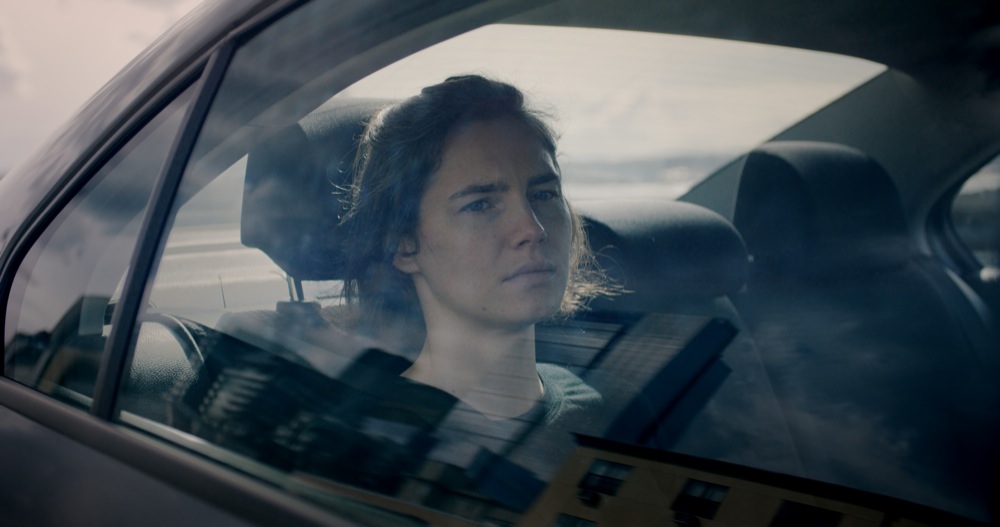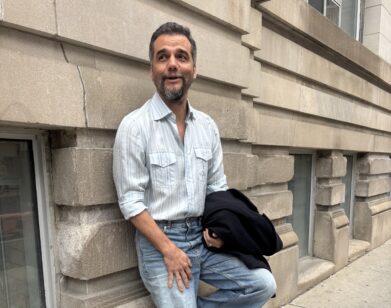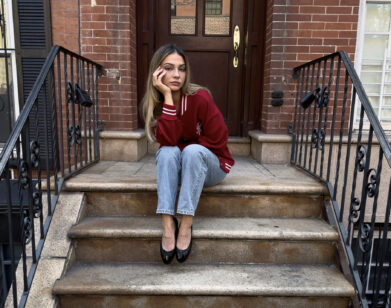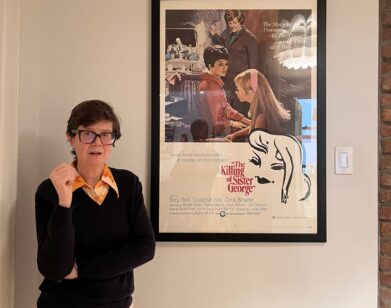Celebrity and Infamy

ABOVE: AMANDA KNOX IN AMANDA KNOX. PHOTO COURTESY OF NETFLIX.
Brian McGinn is quick to emphasize that Amanda Knox, the Netflix documentary he co-directed with Rod Blackhurst, is not a whodunit. “People want to know, ‘What’s the smoking gun?'” He says during a visit to New York shortly after the film’s premiere at the Toronto International Film Festival. “For us, we felt like we didn’t need to do that because the story had been covered so much,” he continues. “Everyone already has an opinion one way or another on the Amanda Knox case, and that fact allowed us to go past that question [of guilt or innocence].”
Instead, McGinn and Blackhurst are more interested in what they deem the “meta questions” raised by Knox’s case: How a tragedy—the murder of a young British student studying abroad in Italy—was twisted into a titillating tale about a sex-crazed seductress; how, while that British student Meredith Know has long been forgotten, the woman twice-acquitted of her murder has become a sort of guilty pleasure celebrity. “The responsibility as a documentary filmmaker is to reflect people’s viewpoints,” McGinn adds. “It’s become so much more than just a court case or a trial or a tragedy. It’s something that millions of people are arguing about online. It’s become such a headline, clickbait driven story.”
EMMA BROWN: You started working on this in 2011, but Amanda didn’t talk to you until 2014.
BRIAN McGINN: Amanda didn’t want to make the movie originally. We knew from the beginning we wanted to make a movie in the first person, which necessitated getting both sides and getting them to open up. Amanda wanted to tell her story in book form, so she wrote a book. We abandoned the project, basically. We did that, I would say, probably three or four times along the way because we weren’t going to be able to get both sides. Then at the end of 2013 she called us. She was facing another verdict at the appellate level in Florence. I think that she felt her life was on the line again; she no longer felt as secure as she had after the 2011 acquittal. I think it was a way for her—as it then became for everyone—to get her side of their story out in a longer form than a lot of the TV news. Everyone used to talk to us about how their words were cut down so much. They would do these extremely long interviews and then 30 seconds would be used. It’s just the nature of how the news business works.
BROWN: So you got started on the film and Amanda and Raffaele Sollecito got acquitted again.
McGINN: Normally you don’t make a retrospective film as the events are happening. Doing that creates problems, but it also creates an opportunity to get peoples’ feelings in the moment and frame those immediate reactions to the events within the context of looking back. I think it helps the movie. But [Guliano] Mignini, who was the prosecutor and the lead investigator, refused interviews for many years. After the final verdict, he said, “Alright, I’ll do it,” and we did a number of days with him. The process in general was just a lot of waiting. Documentary filmmaking is not terribly romantic—it’s a lot of waiting and a lot of digging.
BROWN: If there hadn’t been this second appeal, the documentary might not have happened.
McGINN: I don’t think it would have, honestly. We didn’t know it was going to be a movie until Mignini agreed either. We, for a while, had this interview with Amanda that we weren’t really sure what to do with, because we didn’t want to make a film that was just her voice or her point of view.
BROWN: Everyone in this case has been questioned so many times and, as you said before, has felt like their words have been taken out of context. How do you interview under those circumstances? They must be inherently suspicious of the process.
McGINN: The first thing you do is you don’t ask “gotcha” questions. It was much more conversational. When I was doing the interviews, I had a sheet of paper that had topics I wanted to cover but I didn’t ever write down any questions. It was what emerged. I think because we weren’t guided by that traditional back-and-forth interrogation—”What did this mean? What did that mean?”—it allowed it to unfold in a way where everyone felt in control.
BROWN: Did people seize up if you asked them to clarify things? “I’ve already told you.”
McGINN: No, no one really did that. There was always a distance, so the challenge with doing interviews like that is that it requires finding a connection. As you’re sitting across from them, you’re making eye contact and you’re encouraging them to tell you their story. That encouragement is the thing that, hopefully, makes them open up and in some ways forget that they’re doing an interview. That process mainly consisted of talking to them for quite a while. We had so much coffee with Giuliano Mignini before sitting down with him; we talked so much to Amanda in the process of trying to get her to do the interview to begin with. By the time we sat down, there was a familiarity between us and each of the people that, I think, allowed for them to feel comfortable. It transpired over such a long period of time—we made it over the course of five years—once each of them saw that we weren’t immediately turning around and selling their words to the highest bidder, like had happened in some cases in this story, it allowed them to be even more open.
BROWN: When you are gaining someone’s trust like that, how do you avoid feeling a responsibility towards them?
McGINN: We told each of them at the very beginning, “You will see the film before anyone else in the world sees it. You’re going to know that we’re not manipulating your words, that no matter what anyone else in the world says about the film after it comes out, we have done right by you.” I really feel like the responsibility is that the people see themselves in the final film. There’s definitely a responsibility to reflect both sides as evenly as you possibly can. It’s something that’s so divisive and each side is so passionate that really the only way to deal with that is for us to feel as though its reflecting these peoples’ viewpoints no matter what makes a better “film.”
BROWN: In terms of Meredith Kirchner, how did you decide how present to have her in the film?
McGINN: It was something that was a big concern for us. Especially with the rise of films in this kind of space, it’s always a tough thing to figure out as a filmmaker how do you balance those voices. We reached out to the Kirchner family a number of times and we really wanted them to be in the film. But we had to respect their decision. When we didn’t hear back from them, we found a number of other interview pieces with them that we felt reflected their viewpoints at parts of the film. The story is called Amanda Knox, and that’s because the story was made to be about Amanda and that’s the way that the entire world covered it.[So] it was important for us to draw a line between that tragedy that is very direct at the beginning of the film—the prosecutor talks about that moment when the family first arrived in Perugia and the connection that he felt to their suffering—[and when] the story went off the rails over the next hour of the film. Regardless of whether you believe Amanda is innocent or guilty, the story had gotten so far away from Meredith and the tragedy. At the end of the film, we reminded everyone that Meredith’s family is still trying to process what happened. To imagine what they must be going through is really hard. I think all we can really do is have incredible empathy for them and what they’ve gone through and respect their position.
BROWN: Nick Pisa seems too good to be true. He’s so ridiculous. How did you find him?
McGINN: As we were digging through newspaper articles and footage and headlines, we discovered that there were a couple of key people who were generating a lot of the initial stories. The way that it worked—which, of course, is how it all works now in the media—is that things would be generated from the very center of the story and then they would bleed outwards until they became part of the cultural landscape. Nick was one of the first journalists on the scene. He was reporting not only for the Daily Mail and traditional tabloid papers, but for NBC, for Sky News. He was a freelance journalist in the fashion that moment in time had created because all of the major papers and TV outlets were cutting back on their foreign correspondents. It used to be that you’d have a foreign correspondent in every major city or country and tabloid news and hard were totally separate. In this case, things really began to merge. Articles that would have traditionally just been tabloid things started to bleed into the major newspapers and into the consciousness. Nick was extremely good because he spoke Italian and could integrate himself into the Perugian landscape. He would get information and report it and then three years later we’d see that exact same information come through in the way the Western media was covering the story. That subtle connective tissue between all of those elements was really fascinating to us. In a lot of ways, the film is about how the media works in that way and how all of us, to some extent, are unaware of how the narratives that we see every day and we buy into are constructed.
BROWN: When you interview the principle people involved in the case in the film, the camera often lingers on their faces after they’ve stopped talking. I found that incredibly disconcerting. What made you do that and how do you feel it affected the audience’s perception of the person being interviewed?
McGINN: That was a style that our editor Matt Hamachek kind of stumbled on. It emerged because we talked so much as a group about the way that everyone looked into the eyes of each of these people and came to their conclusions about them. There’s an old film school technique called the Kuleshov effect. It was a Russian guy who edited a woman’s face—a stoic face with no reaction—and cut it against a number of different images that evoked emotion in the audience: a baby carriage rolling down stairs, a woman in a coffin, a nice plate of food. In this experiment, the audience saw their own personal emotional reaction in the person’s eyes, even though the expression had not changed. For us, this case became that sort of Rorschach test for each of these people. Depending on your world view or your cultural bias or whatever, you see these people differently. It felt like a nice way to continue to discuss that; by the end of the film, the point is made that that approach of judging people doesn’t necessarily lead to more clarity, sometimes it leads to less clarity.
BROWN: When I was at TIFF, everyone was talking about Amanda, and how Amanda was the one “celebrity” they wanted to see. Was that strange? Were you expecting that?
McGINN: We invited all the people who are in the film. We want them to come see it in public and it’s up to them whether or not they do that. Amanda wasn’t representing the film in Toronto; it was her choice to attend as a personal decision. I think the thing we’ve been very surprised by is the celebrity attention—almost as if we’re talking about Brad Pitt and Angelina Jolie. For us, at the heart of the story, all of these people have been kind of trapped in these narratives and defined as people that are seeking attention or seeking fame. Each of these people want to tell their version of a story that has left an indelible mark on their life. I think that’s only a natural human desire, to have your side heard. The idea of accidental celebrity—that if we see someone’s picture on the front-page, we feel like we know them and we can figure out what they’re capable of or what they’re not —is a uniquely 2016 idea. That, for us, is the curious thing. [Speaking] out—no matter what side you’re on—is more about [it being] an advantageous thing for you. I’m not really sure if that’s true in any of these peoples’ cases. I think it’s more about a real desire to set the record straight.
AMANDA KNOX IS NOW AVAILABLE TO STREAM VIA NETFLIX.






